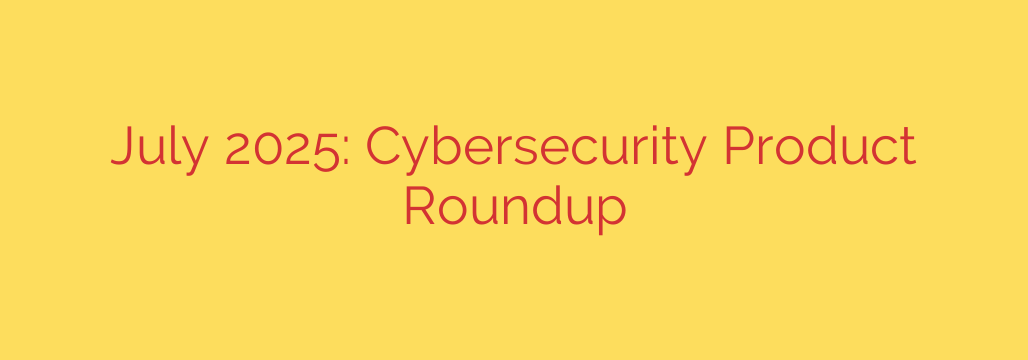
Staying Ahead of the Curve: A Look at Top Cybersecurity Trends in 2025
The digital threat landscape is in a state of constant, rapid evolution. As businesses embrace more complex technologies and threat actors develop increasingly sophisticated methods, the cybersecurity tools we rely on must do more than just keep pace—they must anticipate the future. As we move through 2025, several key trends in cybersecurity products are emerging, defining a new era of digital defense focused on intelligence, integration, and proactive resilience.
Here’s a look at the critical developments shaping how organizations protect their most valuable digital assets.
AI-Driven Security: From Reactive to Predictive
For years, Artificial Intelligence (AI) and Machine Learning (ML) have been instrumental in threat detection. Now, we are seeing a significant shift from reactive analysis to proactive, predictive defense. The latest security platforms are moving beyond simply identifying anomalies in network traffic. They are now capable of forecasting potential attack vectors before they are exploited.
These next-generation systems analyze global threat intelligence, dark web chatter, and internal vulnerabilities to model likely attack scenarios specific to an organization. This allows security teams to patch vulnerabilities and harden defenses against an attack that hasn’t even happened yet. Instead of a Security Operations Center (SOC) chasing alerts, AI-powered platforms are delivering prioritized, predictive guidance, fundamentally changing the security paradigm from defense to pre-emptive neutralization.
The Maturation of Zero Trust Architecture (ZTA)
Zero Trust is no longer a buzzword; it’s the foundational principle for modern network security. In 2025, Zero Trust Architecture has matured from a network-centric model to a much more granular, identity-aware framework. The core principle—”never trust, always verify”—is now being applied at every level of the tech stack.
Leading solutions now offer dynamic, context-aware access control for individual applications and data sets, not just network segments. This means access is granted based on user identity, device health, geographic location, and the specific data being requested, with verification happening continuously. If any part of the context changes, access can be instantly revoked. This micro-segmentation drastically reduces the attack surface and contains breaches by preventing lateral movement across a network.
Unified Endpoint and IoT Security with Advanced XDR
The line between traditional endpoints (laptops, servers) and Internet of Things (IoT) devices has blurred. From smart sensors in a factory to connected medical devices in a hospital, every connected device is a potential entry point for attackers. In response, Extended Detection and Response (XDR) platforms have become essential.
Unlike traditional Endpoint Detection and Response (EDR), modern XDR solutions integrate security telemetry from a much wider range of sources, including network hardware, cloud infrastructure, email systems, and IoT/OT devices. This provides a single, unified view of a potential threat as it moves across different parts of the organization. For security teams, this means faster, more accurate threat detection and a more coordinated, automated response without the need to juggle multiple, disconnected security tools.
The Dawn of Commercial Quantum-Resistant Cryptography
While the threat of quantum computers breaking current encryption standards may still seem distant, the preparation phase is already here. Leading cybersecurity vendors are now rolling out the first commercially viable products featuring Post-Quantum Cryptography (PQC). These solutions are designed to protect long-term data that must remain secure for decades to come.
The focus is on “crypto-agility”—the ability for an organization to seamlessly transition to new cryptographic standards without a complete system overhaul. Security products are now being built with modular cryptographic libraries that can be updated as PQC algorithms are standardized. Organizations handling highly sensitive government, financial, or intellectual property data are beginning to adopt these forward-looking encryption methods to safeguard against “harvest now, decrypt later” attacks.
Actionable Steps for a More Secure Future
Staying secure in this advanced landscape requires more than just purchasing new tools. It demands a strategic approach to security.
- Audit Your Current Security Stack: Identify gaps in your defenses, especially concerning IoT visibility and cloud application security. Determine where a unified XDR or a more robust Zero Trust framework could consolidate and strengthen your posture.
- Prioritize Crypto-Agility: When procuring new systems or updating existing ones, ask vendors about their roadmap for Post-Quantum Cryptography. Ensure your infrastructure can adapt to new encryption standards in the future.
- Invest in Continuous Training: The most advanced tools are only effective if your team knows how to use them. Invest in training that focuses on proactive threat hunting, interpreting AI-driven insights, and managing automated response workflows.
- Embrace Automation: Allow your security tools to handle routine, high-volume tasks. This frees up your human analysts to focus on complex threat investigation, strategic planning, and managing the sophisticated new generation of security platforms.
Ultimately, the future of cybersecurity is intelligent, integrated, and proactive. By understanding these key product trends and taking strategic steps to adapt, organizations can build a resilient defense capable of withstanding the threats of today and tomorrow.
Source: https://www.helpnetsecurity.com/2025/08/01/infosec-products-of-the-month-july-2025/








